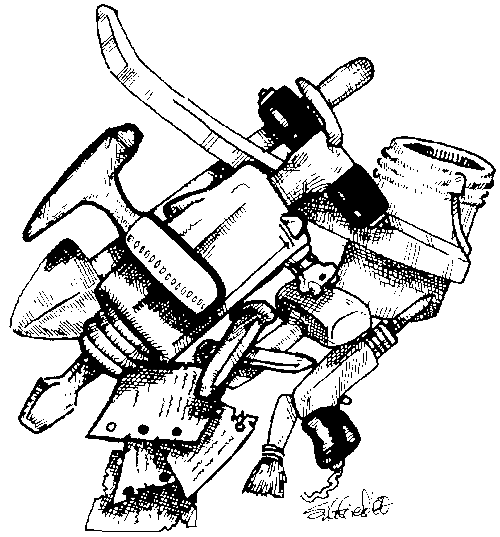








Process

Tools
Paleontologists use a great variety of tools in their field of work. They use special equipment to identify fossils once they are extracted. They also use many different tools in the actual extraction process of the fossil. Some of these tools are used before the extraction process like the camera, magnifers, and measuring tapes. The rest of the tools are mainly used for the hard labour in the extraction process like the chisel, gad/crow bars, etc...These are just some of the basic tools that an amateur paleontologist will use. There are many more specialized tools for the professionals to use. There is a detailed list below of the tools paleontologists use and how they use them.
Camera
- Taking pictures of a location is always a good idea. When you're taking pictures, be sure to always include something to give your subject a reference size, such as a coin, measuring tape, or a friend.
Chipping Hammer
- Like a mason's hammer it has a flat blade at the back end for splitting or trimming rock. This hammer is very useful when working in shales or other thinly laminated rock.
Chisel
- These are used for breaking up rock or removing a little bit of rock at a time when working close to the specimen.
Compass
- Needed if you are keeping good notes on your location or hiking in remote areas. Used for locating a specimen on a grid and then finding it again. Most people use the GPS system now.
Crack/Sledge Hammer
- These hammers are useful when you are doing some serious excavation in hard rock or you need to drive large chisels.
Dental Pick
- For actually getting small fossils loose or exposed from the rock you need a finely pointed tool. Ice picks, dental picks or just a small nail stuck in the end of a dowel are handy. Used in sandstone.
Dust Brush
- Three types are recommended to remove debris from the area: a small soft brush, a wide soft brush, and a stiff brush (old toothbrush). Straw brushes and brooms also can come in handy.
Gad Pry or Crowbar
- There are times when you need to split larger rocks than your chisels can handle. The gad pry has a point at one end and a short right-angled blade at the other for prying layers apart. Crowbars are useful for turning and moving big stuff and come in many sizes.
Geological Hammer
- The classic geologist's pick is always the most useful. It has a square and flat end for busting rock and striking chisels and a pointed pick end for digging, turning and splitting rock.
Magnifer(s)
- The most useful size magnifier is the 10X folding lens. With this power of magnification you can observe most small fossils and diagnostic detail. A larger 3X-hand lens is also handy for scanning rock surfaces.
Measuring Tape
- Used for measuring specimen and recording specimens on a grid. Also used in photographs as a scale.
Safety Gear
- Very important. Includes: goggles, work gloves, sunscreen, shock absorption gloves, dust mask, ear plugs, leggings, steel toe shoes, and a first aid kit.
Shoulder and/or Backpack
- On a professional dig most of the heavier equipment would be driven in as far as possible. Otherwise, all the average fossil hunter would need is a regular sized backpack.
Sieve
- A plastic or wire screen is useful for sifting through dirt or sand. This is often the very best way to search for shark teeth in creek beds. These are often used in Alberta in their sandstone deposits.
Tweezer
- A good pair of tweezers will come in handy if you must collect small pieces without disturbing the matrix or dirt around the specimen.
For the Professionals
- Air compressor, pallets, plaster of Paris, buckets, pneumatic jack hammer, zip gun, mini-jack hammer, hoses, garbage bags, rock saws, come-along, spray paint, string, vinac, butvar-76 dissolved in acetone (to consolidate the bones before jacketing in plaster bandages), epoxy, shovels, fibreglass or burlap, flagging tape, and tents.
Process
Ichthyosaur
Pink Mountain